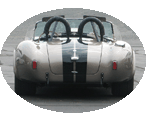
03-03-2009, 08:00 AM
|
 |
Half-Ass Member

|
|
|
Join Date: Jun 2005
Cobra Make, Engine: ERA #732, 428FE (447 CID), TKO600, Solid Flat Tappet Cam, Tons of Aluminum
Posts: 22,025
|
|

 Not Ranked
Not Ranked
 One Interesting Theory...
One Interesting Theory...
... I remember reading this when Shoe posted it. It may be right, it may be wrong, but either way it makes for interesting reading:
Quote:
I'm presently working on the theory that when MCC took over FE block casting after DIF was shut down for the superfund(?guessing?) cleanup, the MCC factory had reason to refer to the block as a "105" rather than a "352". "352" was simply a legacy of DIF - Why should DIF change it if the process works?
It probably refers to the primary project number, and since MCC began molding operations in September 1971, and their fifth mold line came fully on line by December 1972, I'm guessing that "primary project numbers" started at 100 or 101. I'll be looking for numbers like this on other MCC castings, as time permits. Since I don't have any non-FE stuff from the 1970s, it may take a while.
This suggests that "105" markings replaced "352" markings in ALL FE applications from about 1972 or so. Since cars were no longer getting any FEs, this explains why you'll never see a "105" block in a stock automobile.
As for "105" blocks all being FT blocks, forget it! This is just as wrong as saying all 1964-1971 "352" marked castings are FT blocks. Most "105" blocks were cast with standard thickness 360/390/410-type cylinder jackets for 360/390 light truck use. Far fewer were cast with the heavier FT/428-type cylinder jackets.
Since MCC was apparently Ford's first venture into arc melting operations (former Ford foundries used the cupola method - I'm still learning about this), there was a lot of interesting debug going on in the MCC foundry operations. I hypothesize the first FE blocks to emerge from MCC had some "iron chilling" issues in parts of the casting (I've got NO info that supports this). I suspect that adding ribs to the block skirts resolved the "chilling" issue until the MCC processes could be fine tuned. Thickening the walls to reduce chilling would require a notable change to the block design, ribs didn't - suggesting it was an interim reinforcement. This hypothesis matches well with the great frequency which FE blocks were cast with skirt ribs from 1972 to 1975 or so.
Note that "chilling" occurs when certain sections of iron cool too quickly, preventing proper formation of flake graphite and thus promoting formation of solid carbides. Chilling is often used purposely to create wear-resistant and non-deformable features in an otherwise non-chilled casting. Thin cast sections tend to chill more than thick sections.
As for the popular rumor that the ribs were installed because the patterns were wearing out - this doesn't hold much water. Wearing patterns would ttend to thicken wall sections, not thin them as the folklore states. Also, patternmakers were part of the UAW, and I don't think they'd allow Ford to run worn patterns without making lots of fuss about how they were being underfunded. Also, MCC was brand new - patterns would have tended to be brand new about the time the skirt ribs were showing up. It still doesn't make sense, but it'll eventually become clearer.
On a different note, a greater percentage of "105" blocks were cast with reinforced cranksaddles than were "352" blocks. I suspect this was due to the fact that 2.80:1-geared station wagons were no longer getting 390s dropped into them, and a greater percentage of 3.50:1-geared FEs were being put to hauling, plowing, and back-road duty. Ford probably saw a statistical trend in block failures which suggested increased use of reinforced cranksaddle bulkheads would be cheaper than warranty repairs.
It's also been determined that a small but real percentage of FT engines did get plain 360/390 blocks, and a small but real percentage of 360/390 light truck FEs got FT castings. Yes, FT blocks always got the larger distributor pilot hole drilled into them, but this is not a final determination as to whether it originated from an FT casting. To verify it's a genuine FT casting, the best method I've so far come up with is to pop-out the core plugs in the block and feeler-gauge the between the bores to determine nominal cylinder wall thickness.
All just theory at this time,
Shoe.
|
Source: http://www.network54.com/Forum/74182...S+A+105+BLOCK- |